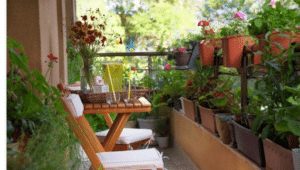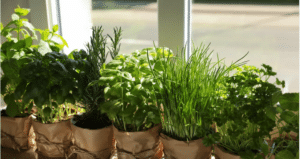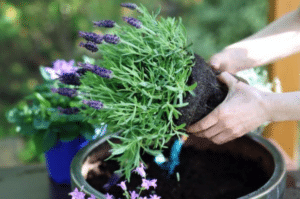 Moments of peace and tranquility can be challenging to find as we rush from one task to another. A friend shared their love of gardening with me and how relaxing they found it. This got me interested, so let me share my experience with you. Gardening can be a great way to slow down, relax, and invite calm into your life. How about creating a therapy garden for yourself—whether you have a sprawling garden, a tiny balcony, or a windowsill?
Moments of peace and tranquility can be challenging to find as we rush from one task to another. A friend shared their love of gardening with me and how relaxing they found it. This got me interested, so let me share my experience with you. Gardening can be a great way to slow down, relax, and invite calm into your life. How about creating a therapy garden for yourself—whether you have a sprawling garden, a tiny balcony, or a windowsill?
Why Create a Therapy Garden?
Therapeutic gardens have been shown to:
Time spent in green spaces helps lower cortisol levels and promotes relaxation.
Exposure to natural light, vibrant colours, and aromatic plants can enhance emotional wellbeing.
Tending to plants and immersing yourself in nature fosters presence and mindfulness.
Gardening is a low-impact physical activity that gets you moving and can improve your overall health.
Designing Your Therapy Garden:
For Small Gardens
Even in a small space, a simple curved or winding path lined with soft plants or stones can create a sense of journey and exploration.
- Use a variety of plant sizes, from low-growing ground covers to taller shrubs, to create a layered effect and give your garden depth.
- Add a small tabletop fountain that can bring the calming sound of flowing water into your garden, encouraging relaxation.
- Choose plants with soft textures, fragrant blooms, and vibrant colors. Think lavender for relaxation or rosemary for its soothing scent.
- A small bench, a swing, or a comfortable chair tucked into a secluded corner can provide a place to sit and appreciate your surroundings.
For Balcony Gardens
 Maximise space by growing plants vertically. Use wall-mounted planters, hanging baskets, or trellises to grow climbing plants like jasmine, morning glory, herbs, or a hanging basket of strawberries.
Maximise space by growing plants vertically. Use wall-mounted planters, hanging baskets, or trellises to grow climbing plants like jasmine, morning glory, herbs, or a hanging basket of strawberries. - Opt for plants that thrive in containers and won’t outgrow your space. Succulents, herbs, dwarf varieties of flowers, or even small trees like lemon or olive trees can work beautifully on a balcony.
- Use tall plants or trellises with climbing vines to create a green “wall” around your balcony. This will provide privacy and a feeling of being surrounded by nature.
- Incorporate plants like scented geraniums, jasmine, mint, and thyme, releasing calming scents as you brush past them.
- Invest in a comfortable chair or small bench. Add a soft blanket or cushion for extra coziness.
For Windowsill Gardens
If you live in a flat or a space with no outdoor area, your windowsill can still serve as a mini therapy garden:
- Select plants that thrive indoors or in small pots, such as succulents, herbs, small flowering plants like African violets, or even a bonsai tree. – An indoor herb garden adds greenery and gives you access to fresh, fragrant herbs. Try basil, mint, parsley, or thyme for a mix of aromas and practical uses.

- Use pots of varying heights or tiered plant stands to create a layered look and maximize the limited space. Even just a few small pots can make a significant impact.
- Small pebbles, shells, or crystals can enhance the natural beauty of your windowsill garden, making it feel more like a peaceful, curated space.
- Plants that love sunlight should be placed closer to the window, while those that prefer indirect light can sit further away.
- Notice the light your windowsill receives throughout the day and move plants around.
Selecting the Right Plants for Your Therapy Garden
No matter the size of your garden, selecting the right plants is key to creating a space that will have a therapeutic effect on you and is really enjoyable, too. Consider the following:
Fragrance
- Lavender, jasmine, gardenia, and rosemary are known for their soothing scents.
Colour
- Use calming colours like blues and purples, which can help reduce stress and anxiety. Bright, cheerful colours like yellow and orange can boost your mood.

Texture
- Soft, touchable plants like lamb’s ear, ferns, and mosses can add a tactile element to your garden and encourage you to connect physically with nature.
Sound
- Add plants like bamboo or grasses that rustle in the breeze, or install a small fountain or wind chime to provide soothing background noise.
Tending to your garden can become a time for reflection and a way to ground yourself in our often-hectic world. Small actions, like watering, pruning, or simply observing your plants, can foster a real sense of calm and connection to nature. Remember, there’s no need for perfection. Your therapy garden should reflect what brings you joy and peace. Happy gardening! 🌱

 Moments of peace and tranquility can be challenging to find as we rush from one task to another. A friend shared their love of gardening with me and how relaxing they found it. This got me interested, so let me share my experience with you. Gardening can be a great way to slow down, relax, and invite calm into your life. How about creating a therapy garden for yourself—whether you have a sprawling garden, a tiny balcony, or a windowsill?
Moments of peace and tranquility can be challenging to find as we rush from one task to another. A friend shared their love of gardening with me and how relaxing they found it. This got me interested, so let me share my experience with you. Gardening can be a great way to slow down, relax, and invite calm into your life. How about creating a therapy garden for yourself—whether you have a sprawling garden, a tiny balcony, or a windowsill? Maximise space by growing plants vertically. Use wall-mounted planters, hanging baskets, or trellises to grow climbing plants like jasmine, morning glory, herbs, or a hanging basket of strawberries.
Maximise space by growing plants vertically. Use wall-mounted planters, hanging baskets, or trellises to grow climbing plants like jasmine, morning glory, herbs, or a hanging basket of strawberries.









